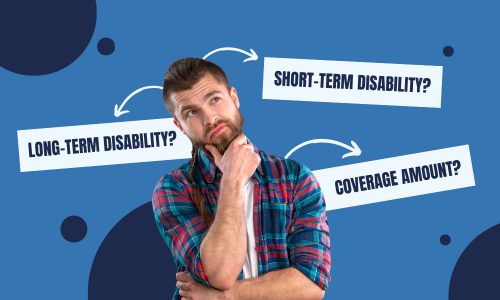Long-term disability insurance (LTD) is a critical but often misunderstood aspect of financial planning. It…

Long-Term vs. Short-Term Disability: What’s the Difference?
In order to make the most of your insurance plans, it is important to understand the difference between various insurance products offered. Long-term and short-term disability insurance are two products that many people are often confused about. Here’s what you need to know about the advantages and disadvantages of each, and how to determine which option is right for you.
Types of Disability-Related Insurance
In general, disability insurance is a type of insurance that will provide supplemental income in the event of an injury or illness that may keep you from working. This type of insurance coverage is important because during an illness or injury there’s already plenty of stress being placed on the family, and financial stress can make things even worse. Disability insurance relieves some of that stress.
Many people get disability insurance and worker’s compensation insurance confused. However, disability insurance is not based on a work-related injury or illness, whereas worker’s compensation is specifically for injuries or illnesses that happen on-the-job.
The two types of disability insurance are short-term and long-term.
- Short-term Disability – A shorter waiting period to get paid, but you get paid for a shorter period of time.
- Long-term Disability – A longer waiting period to get paid, but you get paid for a longer amount of time.
Advantages and Disadvantages
The advantages of long-term disability insurance are obvious, in that you can receive payments for a longer period of time. In some cases, payments may be received until you reach a certain age, such as 65 (when you would be able to claim your social security benefits). However, there is also a disadvantage. With long-term disability insurance, there is generally a longer waiting period between when you become disabled and when you will actually start receiving benefits.
With short-term disability insurance, the main advantage is that in most cases you can get your paperwork filed and payouts set up in a relatively short amount of time. Generally, individuals can begin to receive their payouts in about two weeks. One disadvantage of short-term disability insurance is that these payouts are for a shorter amount of time, usually only up to six months.
Which Is Right For You?
Even once you understand the differences between these two types of insurance coverage, there’s no way to predict what type and severity of the disability or the financial burden it may cause. Ideally, having both short-term and long-term disability insurance would provide maximum coverage across the duration of your injury or illness. However, because premiums vary it is necessary to look at your own personal budget and see which premium(s) you can reasonably afford. Most people find that because long-term disability insurance offers greater protection over time, that it is the preferred choice. Long-term will cover the duration of almost any illness or injury.
If you are ready to take your family’s financial stability to the next level, visit the Texas Bar Private Insurance Exchange today to choose the long-term disability plan that is right for you.

